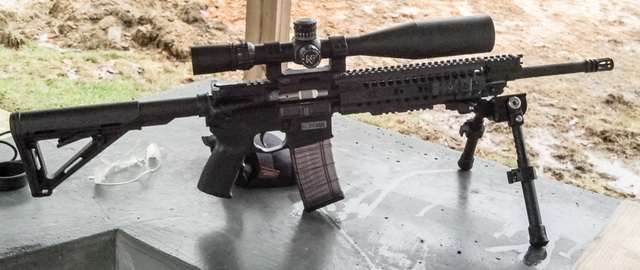
We’ve been questioning what sort of precision we can expect from a piston-driven rifle with a chrome-lined bore. Those are both features believed to reduce accuracy (vs direct-impingement and an unchromed bore). We tested our Ruger SR-556 shooting ten-round groups using the same suite of ammo as in our Savage .223 Precision test and got CEP across the board about 1 MOA (with the exception of the bottom-of-the-barrel Wolf Classic, which produced CEP of 1.5 MOA).
This weekend we got a chance to try a little harder with a Barrett REC7, a premium rifle. Shown above, we fitted it for this test with an LRA bipod and NightForce F1 scope. Five shooters took 10 shots each with two different types of ammo. Given the conditions the shooter variation was minimal. The ammo makes the difference, and this gun sets a new precision benchmark for its type:
| Load | CEP (MOA) | 90% Confidence Interval |
|---|---|---|
| Federal Gold Medal Match 77gr | 0.50 | (0.45, 0.57) |
| American Eagle XM193 | 0.96 | (0.86, 1.13) |
If this rifle has a gas cut off feature could you repeat the test without the gas on? I am really curious how much disturbance the gas piston adds.
The REC7 gas valve only has two positions (for suppressed and regular). However I have tested both the Ruger SR-556 and the XCR with gas shut off in the past and it doesn’t seem to affect accuracy.
The reason a piston system is theorized to degrade accuracy is that it is an additional and substantial point of contact on the barrel, so the barrel can’t be as “free-floated” as with, say, a direct-impingement rifle where the light gas tube is carefully threaded through the barrel nut. The piston barely starts moving before the bullet has left the barrel so I’d be surprised to find disabling the piston affecting accuracy.
Just came across this old thread which shows M193 and M855 shooting mean radius from 0.78″-1.14″ at 100 yards under ideal conditions from an AR-15 with heavy chrome-lined barrel.